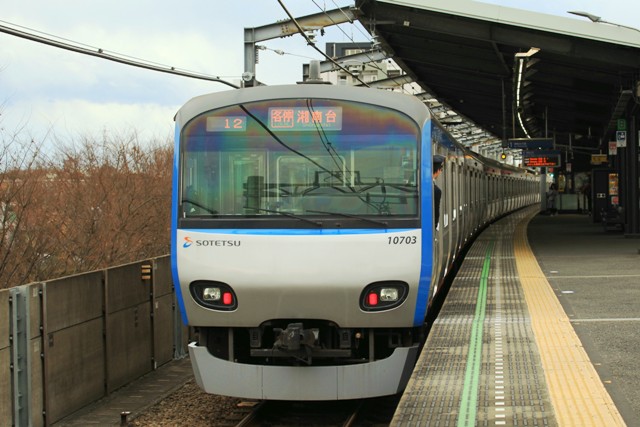EMU JR East 209-2100 series passes through Minatogawa bridge on the Uchibo line
Futtsu is a local city in Chiba Prefecture about 90 kilometers southeast of Tokyo. It is situated on the western side of Boso Peninsula facing Tokyo Bay. I recently visited there with my family on a weekend.
There is a rising sightseeing spot in Futtsu City. It is a hand-cut tunnel named Torozaka-daishi Tunnel located in the Nokogiriyama area. This strange shaped hand-cut tunnel was constructed as an approach to Torozaka-daishi temple by local people more than 100 years ago. The tunnel length is about 100 meters; while the height is about 10 meters. We can see dipping geological beds on both sides of the tunnel walls.
According to the local people, Torozaka-daishi Tunnel is a "power spot", which is a location thought to be flowing with mystical energy. A person who visits a power spot will obtain energy from the land. For your information, "power spot" may be an English word coined in Japan. I don't know exactly why Torozaka-daishi Tunnel is thought to be a power spot, but a cool breeze that passes through the tunnel may give energy to the visitors at least.
To get to this power spot, the closest railway station is Kazusa-Minato on the JR East Uchibo line. On the way back home, I could take a photo of a local train, the EMU 209-2100 series, crossing Minatogawa bridge backed by the blue sky and Tokyo Bay.
We got energy from Futtsu city on the weekend.
There is a rising sightseeing spot in Futtsu City. It is a hand-cut tunnel named Torozaka-daishi Tunnel located in the Nokogiriyama area. This strange shaped hand-cut tunnel was constructed as an approach to Torozaka-daishi temple by local people more than 100 years ago. The tunnel length is about 100 meters; while the height is about 10 meters. We can see dipping geological beds on both sides of the tunnel walls.
According to the local people, Torozaka-daishi Tunnel is a "power spot", which is a location thought to be flowing with mystical energy. A person who visits a power spot will obtain energy from the land. For your information, "power spot" may be an English word coined in Japan. I don't know exactly why Torozaka-daishi Tunnel is thought to be a power spot, but a cool breeze that passes through the tunnel may give energy to the visitors at least.
To get to this power spot, the closest railway station is Kazusa-Minato on the JR East Uchibo line. On the way back home, I could take a photo of a local train, the EMU 209-2100 series, crossing Minatogawa bridge backed by the blue sky and Tokyo Bay.
We got energy from Futtsu city on the weekend.
Torozaka-daishi Tunnel near Kazusa-Minato station on the JR East Uchibo line
Official information about the EMU JR East 209 series (in Japanese):



















